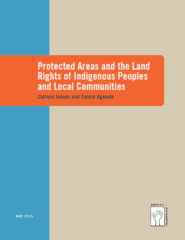
The relationship between protected areas and community land rights is important for both human rights and biodiversity conservation at a global scale. It is important for human rights because land and natural resources are fundamental to the existence, livelihoods, cultural heritage, identity, and future opportunities of Indigenous Peoples and local communities. Customary rights to land and resources, particularly for Indigenous Peoples, are clearly recognized in international human rights law.
This report aims to increase the understanding of the diverse tenure situations that exist within and outside protected areas and to direct attention to the issues associated with community land and resource rights in conservation. It assesses how protected areas in a range of countries relate to Indigenous Peoples and community land and resource rights, and the implications of these relationships for human rights and biodiversity conservation. The analysis encompasses all 17 “megadiverse” countries1 (identified as the world’s most biodiversity-rich countries, containing at least two-thirds of all non-fish vertebrate species and three-quarters of all higher plant species), as well as four other high-biodiversity countries.
